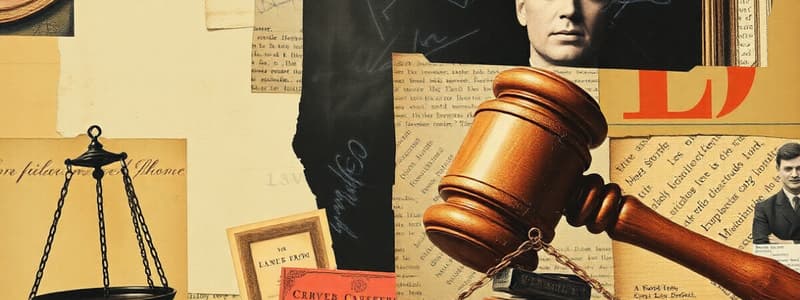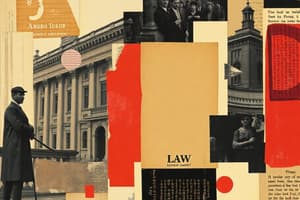Podcast
Questions and Answers
What is the earliest known codified law?
What is the earliest known codified law?
The Code of Hammurabi
What is the name of the document that outlines the limitations on the rights of the crown?
What is the name of the document that outlines the limitations on the rights of the crown?
The Magna Carta
The Magna Carta was the first law in written form in history.
The Magna Carta was the first law in written form in history.
False (B)
What is the main purpose of retribution as a form of punishment?
What is the main purpose of retribution as a form of punishment?
What is the main goal of rehabilitation as a form of punishment?
What is the main goal of rehabilitation as a form of punishment?
What are the two main roles of the judge in a case using an inquisitorial system?
What are the two main roles of the judge in a case using an inquisitorial system?
What are the two main roles of the judge in a case using an adversarial system?
What are the two main roles of the judge in a case using an adversarial system?
When a law is deemed unconstitutional based on the Oakes Test, what does that mean?
When a law is deemed unconstitutional based on the Oakes Test, what does that mean?
What does the "Notwithstanding Clause" allow governments to do?
What does the "Notwithstanding Clause" allow governments to do?
What is the main legal document that defines criminal offenses in Canada?
What is the main legal document that defines criminal offenses in Canada?
What is defined as a quasi-criminal offense?
What is defined as a quasi-criminal offense?
Direct evidence is ______ evidence, unlike circumstantial evidence.
Direct evidence is ______ evidence, unlike circumstantial evidence.
What is the burden of proof in a criminal case?
What is the burden of proof in a criminal case?
In a civil case, what is the burden of proof?
In a civil case, what is the burden of proof?
In the context of legal systems, what is meant by 'due process'?
In the context of legal systems, what is meant by 'due process'?
What is the legal standard for determining whether an accused is guilty in a criminal case?
What is the legal standard for determining whether an accused is guilty in a criminal case?
What is the significance of the 'reasonable doubt' standard in the legal proceedings?
What is the significance of the 'reasonable doubt' standard in the legal proceedings?
What does it mean when a judge or jury finds the accused 'not guilty'?
What does it mean when a judge or jury finds the accused 'not guilty'?
What is the term for the legal concept that deals with the responsibility of employers to provide safe working conditions for their employees?
What is the term for the legal concept that deals with the responsibility of employers to provide safe working conditions for their employees?
What is the legal framework for establishing contracts between individuals and businesses?
What is the legal framework for establishing contracts between individuals and businesses?
The concept of 'negligence' in law typically deals with intentionally causing harm to another person.
The concept of 'negligence' in law typically deals with intentionally causing harm to another person.
In law, 'duty of care' requires individuals to act in a way that reasonably prevents any potential harm to others.
In law, 'duty of care' requires individuals to act in a way that reasonably prevents any potential harm to others.
The 'standard of care' in law dictates that everyone is held to the same level of caution and responsibility in every situation.
The 'standard of care' in law dictates that everyone is held to the same level of caution and responsibility in every situation.
What is the legal term for when a person is held criminally liable for the actions of someone else?
What is the legal term for when a person is held criminally liable for the actions of someone else?
In law, what is the term used to describe when a person is held liable for causing harm through their own negligence, even if they did not intend to cause harm?
In law, what is the term used to describe when a person is held liable for causing harm through their own negligence, even if they did not intend to cause harm?
What is the term for a legal defense that claims the accident was unavoidable due to an extraordinary, uncontrollable event?
What is the term for a legal defense that claims the accident was unavoidable due to an extraordinary, uncontrollable event?
What is the term for a legal defense that claims the accused was acting in self-defense to protect themselves from harm?
What is the term for a legal defense that claims the accused was acting in self-defense to protect themselves from harm?
What is the term for a legal defense that claims the accused was acting with the permission of the person involved in the incident?
What is the term for a legal defense that claims the accused was acting with the permission of the person involved in the incident?
What is the term for a legal defense that claims the accused was acting on behalf of a law enforcement officer or another person with legal authority?
What is the term for a legal defense that claims the accused was acting on behalf of a law enforcement officer or another person with legal authority?
What is the term for a legal defense that permits an action that would otherwise be considered a nuisance or unlawful if the action is authorized by law?
What is the term for a legal defense that permits an action that would otherwise be considered a nuisance or unlawful if the action is authorized by law?
What is the term for a legal defense that argues that the accused was acting in defense of someone else from harm?
What is the term for a legal defense that argues that the accused was acting in defense of someone else from harm?
The adversarial system is typically used in criminal proceedings, while the inquisitorial system tends to govern civil cases.
The adversarial system is typically used in criminal proceedings, while the inquisitorial system tends to govern civil cases.
The 'burden of proof' in a criminal case is much lower compared to a civil case, requiring only a balance of probabilities for the prosecution to prove their case.
The 'burden of proof' in a criminal case is much lower compared to a civil case, requiring only a balance of probabilities for the prosecution to prove their case.
In an inquisitorial system, the judge functions primarily as a neutral referee, while in an adversarial system, the judge has a more active role in gathering evidence and determining guilt.
In an inquisitorial system, the judge functions primarily as a neutral referee, while in an adversarial system, the judge has a more active role in gathering evidence and determining guilt.
In Canada, courts use the adversarial system for criminal cases and the inquisitorial system for civil cases.
In Canada, courts use the adversarial system for criminal cases and the inquisitorial system for civil cases.
Restorative justice aims to achieve what?
Restorative justice aims to achieve what?
What type of justice is primarily focused on punishing the offender for the crime?
What type of justice is primarily focused on punishing the offender for the crime?
What is the main goal of reformative justice?
What is the main goal of reformative justice?
What is the main focus of restorative justice?
What is the main focus of restorative justice?
What is the term for a reduced sentence or early release from prison that is designed to allow the offender to reintegrate into society?
What is the term for a reduced sentence or early release from prison that is designed to allow the offender to reintegrate into society?
What is the term for a sentence that allows the offender to remain in the community while being monitored and supervised?
What is the term for a sentence that allows the offender to remain in the community while being monitored and supervised?
What is the term used to describe the likelihood of an offender re-offending after they are released from prison?
What is the term used to describe the likelihood of an offender re-offending after they are released from prison?
Flashcards
Common Law
Common Law
Common law is the body of law created by judges' decisions in cases over time. It emphasizes consistency by ensuring judges rule based on similar cases. Also, it provides flexibility as laws evolve.
Code of Hammurabi
Code of Hammurabi
The Code of Hammurabi, a Babylonian legal text from 1755-1750 BC, is considered the earliest known codified law system. Its significance lies in establishing consistent legal practices within a jurisdiction.
Retribution
Retribution
Retribution signifies punishment based on the concept of payback or vengeance, aiming to achieve a sense of justice by inflicting pain on the wrongdoer.
Jurisdiction
Jurisdiction
Signup and view all the flashcards
Procedural Law
Procedural Law
Signup and view all the flashcards
Restitution
Restitution
Signup and view all the flashcards
Magna Carta
Magna Carta
Signup and view all the flashcards
Rehabilitation
Rehabilitation
Signup and view all the flashcards
Rule of Law
Rule of Law
Signup and view all the flashcards
Greek Law
Greek Law
Signup and view all the flashcards
Reasonable Limits Clause
Reasonable Limits Clause
Signup and view all the flashcards
R. v. Morgentaler
R. v. Morgentaler
Signup and view all the flashcards
Sauvé v. Canada
Sauvé v. Canada
Signup and view all the flashcards
The White Paper
The White Paper
Signup and view all the flashcards
R v Keegstra
R v Keegstra
Signup and view all the flashcards
Rodriguez v. B.C.
Rodriguez v. B.C.
Signup and view all the flashcards
Notwithstanding Clause
Notwithstanding Clause
Signup and view all the flashcards
Equality Rights
Equality Rights
Signup and view all the flashcards
R v Big M Drug Mart
R v Big M Drug Mart
Signup and view all the flashcards
R v Vriend
R v Vriend
Signup and view all the flashcards
Immigration Act, 1976
Immigration Act, 1976
Signup and view all the flashcards
CUPE Strike, 2022
CUPE Strike, 2022
Signup and view all the flashcards
Criminal Code of Canada
Criminal Code of Canada
Signup and view all the flashcards
Circumstantial Evidence
Circumstantial Evidence
Signup and view all the flashcards
Burden of Proof
Burden of Proof
Signup and view all the flashcards
Direct Evidence
Direct Evidence
Signup and view all the flashcards
Parole
Parole
Signup and view all the flashcards
Probation
Probation
Signup and view all the flashcards
Recidivism
Recidivism
Signup and view all the flashcards
Due Process
Due Process
Signup and view all the flashcards
Reasonable Doubt
Reasonable Doubt
Signup and view all the flashcards
Acquittal
Acquittal
Signup and view all the flashcards
Actus Reus & Mens Rea
Actus Reus & Mens Rea
Signup and view all the flashcards
Quasi-Criminal
Quasi-Criminal
Signup and view all the flashcards
Family Law
Family Law
Signup and view all the flashcards
Labour Law
Labour Law
Signup and view all the flashcards
Negligence
Negligence
Signup and view all the flashcards
Liability
Liability
Signup and view all the flashcards
Contract Law
Contract Law
Signup and view all the flashcards
Commercial Law
Commercial Law
Signup and view all the flashcards
Property Law
Property Law
Signup and view all the flashcards
Estate Law
Estate Law
Signup and view all the flashcards
Act of God
Act of God
Signup and view all the flashcards
Duty of Care
Duty of Care
Signup and view all the flashcards
Standard of Care
Standard of Care
Signup and view all the flashcards
Study Notes
Common Law/Case Law
- Common law is law made by judicial decisions over time.
- It ensures consistency as judges must base rulings on similar cases.
- It allows for flexibility as laws change.
Procedural Law
- This area of law guides the procedures of law enforcement and courts.
- It ensures fairness and due process.
Code of Hammurabi
- Babylonian legal text (1755-1750 BCE).
- Earliest known codified laws.
- Set the standard for codifying laws.
Magna Carta
- "Greater Charter" limiting the rights of the English crown.
- First constitution, limiting the power of the king.
- Established that the King and the Government are not above the law.
Retribution
- Punishment based on payback or vengeance.
- It embodies a sense of justice, taking satisfaction from the wrongdoer being punished.
Restitution
- Compensation for a crime victim.
- Introduced democratic values and protected the lower class.
Jurisdiction
- The parameters of power in a court system.
- Determines which courts have authority.
- Ensures different agencies don't overlap in powers.
Adversarial System
- The minimal role of the judge is just a referee, and determining guilt/sentencing relies on arguments by the defense/prosecution.
- Commonly used in criminal law cases.
Inquisitorial System
- The judge plays a major role, asking questions and guiding the case.
- Used in civil law cases because the parties are required to prove their case to the judge.
Rehabilitation
- Punishment focusing on reforms (treatment, training) of offenders allowing them to become law-abiding members of society.
- Aims to reduce recidivism.
Rule of Law
- Principle that no one is above the law.
- Ensures fairness and equal treatment.
- Applies to all citizens regardless of political or social status..
Greek Law
- Ancient Greek rules and regulations.
- Led to the development of democratic practices like juries.
Reasonable Limits Clause
- Determines the constitutionality of laws.
- Used to balance individual rights and societal needs.
Human Rights Unit
- Cases involve issues of human rights, including abortion issues.
- Examples include R v Morgentaler and Sauvé v Canada.
Criminal Code of Canada
- Document defining criminal offenses and punishments.
- Concise and accessible.
Studying That Suits You
Use AI to generate personalized quizzes and flashcards to suit your learning preferences.




